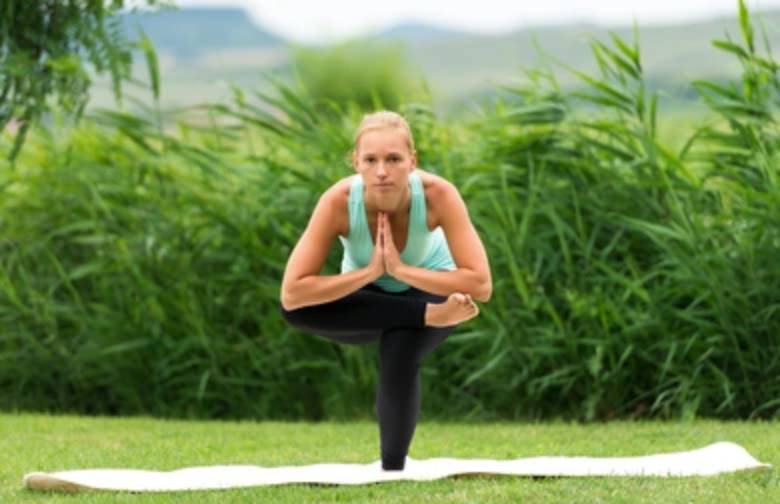Standing Pigeon Pose, also known as Eka Pada Galavasana in Sanskrit, is a challenging yet rewarding yoga pose that offers a multitude of physical and mental benefits. This article will provide a comprehensive guide on how to perform the pose correctly, its benefits, various poses, precautions, common mistakes, and scientific evidence supporting its practice.
Benefits of Standing Pigeon Pose.
Standing Pigeon Pose offers numerous benefits for the body and mind, including:
1. Hip Flexibility: The pose stretches and opens the hip flexors, promoting flexibility and mobility in the hips.
2. Improves Balance: Balancing on one leg strengthens the muscles in the legs and core, improving overall balance and stability.
3. Strengthens Core Muscles: Engaging the core muscles to maintain the pose strengthens the abdominal muscles and improves core stability.
4. Stress Relief: The focus required to perform the pose helps calm the mind and reduce stress and anxiety.
5. Improves Concentration: Practicing Standing Pigeon Pose enhances concentration and mental focus.
How to Perform Standing Pigeon Pose?
Follow these steps to perform Standing Pigeon Pose correctly:
1. Start in Mountain Pose: Stand tall with your feet hip-width apart, arms by your sides, and shoulders relaxed.
2. Shift Weight to One Leg: Shift your weight onto your left leg and lift your right foot off the ground.
3. Cross Right Ankle Over Left Knee: Cross your right ankle over your left knee, flexing the right foot to protect the knee joint.
4. Bend Supporting Leg: Bend your left knee and lower your hips as if sitting back into a chair.
5. Fold Forward: Hinge at the hips and fold forward, bringing your chest towards your left thigh.
6. Extend Arms: Extend your arms forward for balance or bring your hands together in prayer position at your heart center.
7. Hold the Pose: Hold the pose for 30 seconds to 1 minute while maintaining steady breath.
Common Mistakes to Avoid.
Avoid these common mistakes to ensure proper alignment and safety while practicing Standing Pigeon Pose:
1. Overarching the Lower Back: Keep the lower back neutral and avoid arching excessively to protect the spine.
2. Putting Too Much Weight on the Knee: Avoid putting excessive weight on the knee of the supporting leg to prevent injury.
3. Rounding the Shoulders: Keep the shoulders relaxed and away from the ears to maintain proper alignment.
4. Not Engaging the Core: Remember to engage the core muscles to support the lower back and maintain balance.
5. Forcing the Stretch: Ease into the pose gradually and avoid forcing the stretch beyond your body’s limits.
Precautions.
While Standing Pigeon Pose offers many benefits, it may not be suitable for everyone. Consider the following precautions before practicing the pose:
1. Injury or Pain: If you have a hip, knee, or lower back injury, consult with a healthcare professional before attempting the pose.
2. Pregnancy: Pregnant individuals should avoid deep hip-opening poses like Standing Pigeon Pose, especially in the later stages of pregnancy.
3. High Blood Pressure: If you have high blood pressure or any cardiovascular issues, practice the pose with caution and avoid holding your breath.
4. Balance Issues: Individuals with balance issues or vertigo should practice near a wall or with the support of a chair for stability.
Scientific Evidence Supporting Standing Pigeon Pose.
While research specifically on Standing Pigeon Pose is limited, studies have shown the benefits of similar yoga poses and hip-opening exercises. For example, a study published in the International Journal of Yoga Therapy found that yoga practices involving hip-opening poses can improve hip flexibility and reduce lower back pain.(1)
Frequently Asked Questions.
Yes, beginners can practice Standing Pigeon Pose, but they should start slowly and listen to their bodies. It’s essential to focus on proper alignment and avoid pushing beyond your limits.
If you have tight hips, you can place a yoga block or cushion under your sitting bones for support. This can help alleviate discomfort and allow you to ease into the pose more comfortably.
Individuals with knee injuries should approach Standing Pigeon Pose with caution. They can modify the pose by reducing the depth of the bend in the supporting leg or choosing alternative hip-opening poses that are gentler on the knees.
Bottom Line.
Standing Pigeon Pose is a challenging yet beneficial yoga pose that offers a wide range of physical and mental benefits. By following proper alignment, practicing with mindfulness, and listening to your body, you can experience the transformative effects of this pose in your yoga practice. Remember to consult with a healthcare professional before beginning any new exercise regimen, especially if you have pre-existing health conditions or injuries. Incorporate Standing Pigeon Pose into your yoga routine to improve hip flexibility, balance, and overall well-being.
+1 Source
FitnessQuora has strict sourcing guidelines and relies on peer-reviewed studies, educational research institutes, and medical organizations. We avoid using tertiary references. You can learn more about how we ensure our content is accurate and up-to-date by reading our editorial policy.
- Physical and Physiological Effects of Yoga for an Underserved Population with Chronic Low Back Pain; https://www.ncbi.nlm.nih.gov/pmc/articles/PMC6746048/

 Workout
Workout
 Meditation
Meditation





 Contact Us
Contact Us





